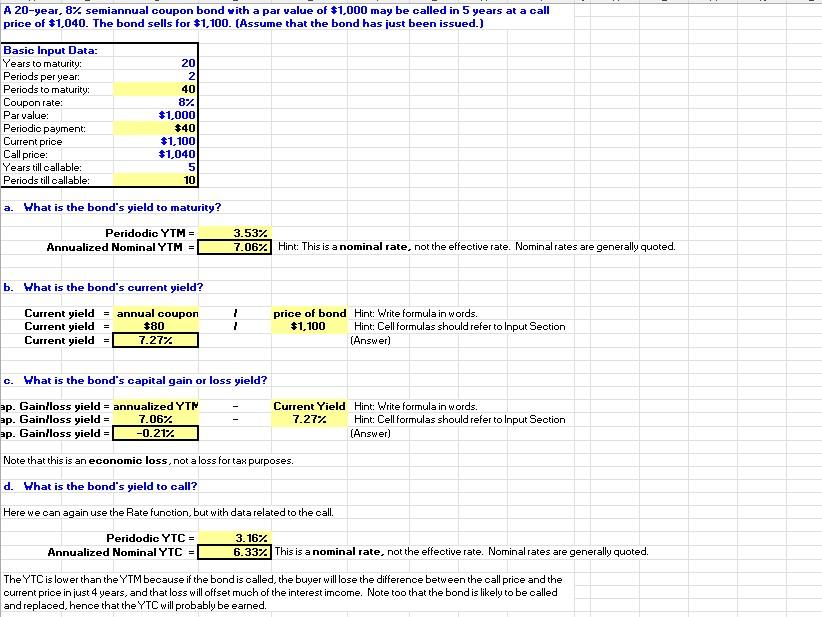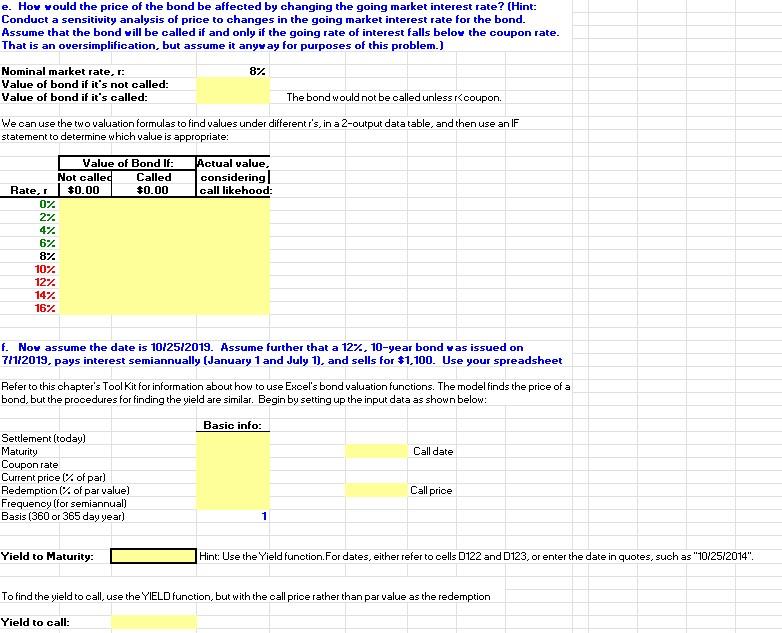Need help on answering section E and F. Please provide formula to input in excel please. Need to know how you got the answer please.


A 20 -year, 8% semiannual coupon bond with a par value of $1,000may be called in 5 years at a call price of $1,040. The bond sells for $1,100. (Assume that the bond has just been issued.) \begin{tabular}{lr|} \hline Basic lnput Data: & \\ \hline Years to maturity: & 20 \\ Periods per year: & 2 \\ \hline Periods to maturity: & 40 \\ Coupon rate: & 8% \\ Par value: & $1,000 \\ Periodic payment: & $40 \\ Current price & $1,100 \\ Callprice: & $1,040 \\ Years till callable: & 5 \\ Periods tilloallable: & 10 \\ \hline & \\ a. What is the bond's yield to maturity? \end{tabular} b. What is the bond's current yield? CurrentyieldCurrentyield=annualcoupon=$80 d. What is the bond's yield to call? Here we can again use the Rate function, but with data related to the call. PeridodicYTC=AnnualizedNominalYTC=3.16%6.33% This is a nominal rate, not the effective rate. Nominal rates are generally quoted. The YTC is lower than the YTM because if the bond is called, the buyer will lose the difference between the oall price and the current price in just 4 years, and that loss will offset much of the interest imcome. Note too that the bond is likely to be oalled and replaced, hence that the YTC will probably be earned. e. How would the price of the bond be affected by changing the going market interest rate? (Hint: Conduct a sensitivity analysis of price to changes in the going market interest rate for the bond. Assume that the bond will be called if and only if the going rate of interest falls below the coupon rate. That is an oversimplification, but assume it anyway for purposes of this problem.) Wominal market rate, r: Value of bond if it's not called: Value of bond if it's called: We can use the two valuation formulas to find values under different is, in a 2-output data table, and then use an IF statement to determine which walue is appropriate: f. Wow assume the date is 1012512019 . Assume further that a 12\%, 10-year bond was issued on 7112019, pays interest semiannually (January 1 and July 1), and sells for $1,100. Use your spreadsheet Refer to this chapter's Tool Kit for information about how to use Excel's bond valuation functions. The model finds the price of a bond, but the procedures for finding the yield are similar. Begin by setting up the input data as shown below: Yield to Maturity: Hint: Use the Yield function. For dates, either refer to cells D122 and D123, or enter the date in quotes, such as "10/25/2014". To find the yield to oall, use the YIELD function, but with the oall price rather than par value as the redemption Yield to call: A 20 -year, 8% semiannual coupon bond with a par value of $1,000may be called in 5 years at a call price of $1,040. The bond sells for $1,100. (Assume that the bond has just been issued.) \begin{tabular}{lr|} \hline Basic lnput Data: & \\ \hline Years to maturity: & 20 \\ Periods per year: & 2 \\ \hline Periods to maturity: & 40 \\ Coupon rate: & 8% \\ Par value: & $1,000 \\ Periodic payment: & $40 \\ Current price & $1,100 \\ Callprice: & $1,040 \\ Years till callable: & 5 \\ Periods tilloallable: & 10 \\ \hline & \\ a. What is the bond's yield to maturity? \end{tabular} b. What is the bond's current yield? CurrentyieldCurrentyield=annualcoupon=$80 d. What is the bond's yield to call? Here we can again use the Rate function, but with data related to the call. PeridodicYTC=AnnualizedNominalYTC=3.16%6.33% This is a nominal rate, not the effective rate. Nominal rates are generally quoted. The YTC is lower than the YTM because if the bond is called, the buyer will lose the difference between the oall price and the current price in just 4 years, and that loss will offset much of the interest imcome. Note too that the bond is likely to be oalled and replaced, hence that the YTC will probably be earned. e. How would the price of the bond be affected by changing the going market interest rate? (Hint: Conduct a sensitivity analysis of price to changes in the going market interest rate for the bond. Assume that the bond will be called if and only if the going rate of interest falls below the coupon rate. That is an oversimplification, but assume it anyway for purposes of this problem.) Wominal market rate, r: Value of bond if it's not called: Value of bond if it's called: We can use the two valuation formulas to find values under different is, in a 2-output data table, and then use an IF statement to determine which walue is appropriate: f. Wow assume the date is 1012512019 . Assume further that a 12\%, 10-year bond was issued on 7112019, pays interest semiannually (January 1 and July 1), and sells for $1,100. Use your spreadsheet Refer to this chapter's Tool Kit for information about how to use Excel's bond valuation functions. The model finds the price of a bond, but the procedures for finding the yield are similar. Begin by setting up the input data as shown below: Yield to Maturity: Hint: Use the Yield function. For dates, either refer to cells D122 and D123, or enter the date in quotes, such as "10/25/2014". To find the yield to oall, use the YIELD function, but with the oall price rather than par value as the redemption Yield to call








